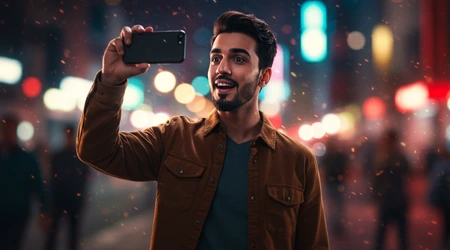The Rise of “Main Character Syndrome” on Social Media

Main Character Syndrome has become a cultural buzzword, capturing a mindset where individuals cast themselves as the protagonists of their own life’s movie.
Anúncios
This phenomenon, fueled by social media’s curated stages, reflects a growing tendency to prioritize personal narratives over collective experiences.
But what drives this self-centered lens, and why does it resonate so deeply in 2025’s digital age? This article dives into the psychology behind Main Character Syndrome, its societal implications, and how it shapes online and offline interactions.
We’ll explore its roots, manifestations, and strategies to balance self-expression with empathy, offering a nuanced look at a behavior that’s as captivating as it is concerning.
Social media platforms like TikTok, Instagram, and X have transformed how we present ourselves, turning everyday moments into cinematic scenes.
Anúncios
The term Main Character Syndrome emerged on TikTok around 2020, describing people who treat life as a scripted drama where they’re the star.
While not a clinical diagnosis, it overlaps with traits like narcissism and low empathy, raising questions about its impact. Is this mindset a harmless boost to self-esteem or a slippery slope toward self-absorption?
With 68% of Gen Z reporting increased self-focus due to social media use (Pew Research, 2024), the phenomenon demands a closer look. Let’s unpack its origins, signs, consequences, and ways to navigate it thoughtfully.
The Roots of Main Character Syndrome
Social media’s design amplifies self-focused behavior, encouraging users to craft idealized personas. Platforms reward attention with likes, shares, and followers, reinforcing a performative mindset.
This creates a feedback loop where validation fuels self-presentation, often at the expense of authenticity.
People curate highlight reels, from perfect outfits to dramatic life updates, to fit a narrative of being the “main character.” This digital stage fosters a culture where standing out feels essential.
The psychology behind this trend ties to human needs for recognition and control. In a world of uncertainty economic shifts, global crises social media offers a space to script one’s story.
For some, Main Character Syndrome is a coping mechanism, masking insecurities or low self-esteem. Yet, this self-focus can spiral, prioritizing personal narratives over others’ realities. The constant spotlight distorts how we view ourselves and those around us.
++ Digital Dopamine: How Apps Hijack the Reward System
Consider a teen filming a TikTok dance in a crowded park, ignoring passersby to perfect their shot. This behavior, while seemingly harmless, reflects a mindset where others become props.
The drive for likes can override social awareness, a hallmark of this phenomenon. Cultural emphasis on individualism, especially in Western societies, further fuels this trend, celebrating personal stories over collective ones.

Signs and Symptoms in the Digital Age
Recognizing Main Character Syndrome involves spotting behaviors that prioritize self over others. People may overdramatize events, framing setbacks as epic plot twists.
They often seek constant validation, posting curated content to maintain an idealized image. Conversations may revolve around their experiences, sidelining others’ stories. This mindset thrives online, where filters and edits craft a flawless protagonist.
Also read: Why the Brain Loves Conspiracy Theories
Another sign is the tendency to view life through a cinematic lens. Someone might narrate their coffee run as a pivotal scene, expecting others to play supporting roles.
This can strain relationships, as empathy takes a backseat to self-focus. For example, a young professional might dominate a team meeting, redirecting discussions to their ideas, unaware of colleagues’ contributions.
| Behavior | Description | Example |
|---|---|---|
| Attention-Seeking | Craving spotlight through dramatic or loud actions | Posting a tearful video about a minor inconvenience for sympathy |
| Narrative Overdramatization | Framing mundane events as significant plot points | Describing a flat tire as a “hero’s challenge” on Instagram |
| Lack of Empathy | Dismissing others’ experiences to focus on self | Ignoring a friend’s story to share a personal anecdote |
| Curated Online Presence | Crafting an idealized image through selective posting | Using filters to perfect every selfie, ignoring real-life imperfections |
The table above highlights key behaviors, showing how they manifest online and offline. These signs aren’t inherently negative but become problematic when they overshadow others’ needs.
Social media’s instant feedback loop likes, comments, retweets amplifies these tendencies, making self-awareness harder to maintain.
In 2025, the rise of immersive platforms like virtual reality spaces on Meta’s Horizon Worlds has intensified this. Users create avatars that embody their “main character” personas, further blurring reality and performance.
Read more: The Psychology Behind Going “No Contact” in Relationships
This evolution suggests the syndrome is adapting to new technologies, raising questions about its long-term impact.
The Social and Psychological Impact
The consequences of Main Character Syndrome ripple through relationships and mental health. When someone views others as “side characters,” empathy erodes, leading to strained connections.
Friends may feel unheard, colleagues undervalued, and communities fractured. This self-absorption can foster isolation, as genuine bonds require mutual understanding, not one-sided narratives.
Mentally, the pressure to maintain a protagonist’s image can be exhausting. Constantly curating a perfect online persona fuels anxiety and insecurity.
A 2024 study by Pew Research found that 68% of Gen Z users felt increased pressure to appear “special” online, linking social media to heightened self-consciousness.
This relentless pursuit of validation can erode self-esteem when reality falls short of the curated narrative.
Imagine Sarah, a college student who posts daily Instagram stories, framing her life as a glamorous adventure. When her posts don’t get enough likes, she feels inadequate, tying her worth to external approval.
This cycle traps her in a performance mindset, distancing her from authentic connections. Offline, her friends notice she rarely asks about their lives, further straining relationships.
The societal impact is equally concerning. Main Character Syndrome can amplify hyper-individualism, undermining collective values.
In 2025, as global challenges like climate change demand cooperation, this mindset risks prioritizing personal gain over shared goals.
Online shaming, doxxing, or dismissing others as “NPCs” (non-player characters) reflects a dehumanizing trend rooted in this syndrome.
Public incidents highlight this. In 2024, a viral X post showed a TikToker shoving a bystander to film a video, sparking outrage.
Such actions reveal how the quest for attention can harm others, turning real people into mere obstacles. This behavior challenges social norms, raising ethical questions about digital culture’s direction.
Balancing Self-Expression and Empathy
Navigating Main Character Syndrome requires balancing self-expression with empathy. Social media isn’t inherently harmful; it’s a tool that amplifies existing tendencies.
The key is cultivating self-awareness to avoid slipping into self-absorption. Reflecting on how your actions affect others is a start. Are you listening as much as you’re speaking?
Therapy, like cognitive behavioral therapy (CBT), can help address underlying insecurities driving this mindset.
Practicing mindfulness fosters grounding, encouraging you to step out of the “main character” role. Limiting social media use say, an hour daily can reduce the urge to perform. Instead, focus on real-world interactions that build mutual understanding.
Consider James, a young influencer who noticed his friendships fading. He started scheduling “no-phone” coffee dates, actively listening to friends’ stories.
This shift helped him reconnect, proving small changes can counter the syndrome’s effects. Empathy training, like role-playing others’ perspectives, can also reframe how you view your “supporting cast.”
Another strategy is diversifying your online content. Share others’ stories or amplify community voices, not just your own.
In 2025, platforms like X reward authentic, collaborative content, making this a practical step. By celebrating others, you create a richer narrative that doesn’t rely solely on your spotlight.
Engaging in offline hobbies also helps. Volunteering, joining a book club, or learning a craft shifts focus from performance to connection.
These activities remind you that life isn’t a solo script but a shared story. Why not ask yourself: How can I make room for others’ narratives in my daily life?
The Future of Digital Narratives

As technology evolves, so does Main Character Syndrome. In 2025, AI-driven platforms personalize content to an unprecedented degree, intensifying self-focused narratives.
Virtual reality and augmented reality spaces let users live as their idealized avatars, deepening the protagonist mindset. This raises concerns about further detachment from reality and empathy.
Yet, there’s hope. Movements on X and TikTok in 2025 emphasize “ensemble narratives,” where users share collective stories, like community projects or shared challenges.
These counter the solo spotlight, promoting collaboration. Brands and influencers adopting this approach gain traction, suggesting a cultural shift toward inclusivity.
Education plays a role too. Schools are integrating digital literacy into curricula, teaching students to navigate social media mindfully.
Programs that emphasize empathy and critical thinking can curb the syndrome’s spread. By fostering awareness early, we can shape a generation that values connection over self-promotion.
Conclusion: Rewriting the Script
Main Character Syndrome reflects a natural human desire to feel seen, amplified by social media’s seductive stage. While it can boost confidence, it risks isolating us from others’ stories.
In 2025, as digital and real worlds blur, balancing self-expression with empathy is crucial. By recognizing this mindset’s signs and impacts, we can rewrite our narratives to include others, not just ourselves.
Life isn’t a solo movie it’s a collaborative epic. Each person’s story matters, and true connection comes from sharing the spotlight.
So, next time you post, consider: Are you the hero, or can you be part of a larger cast? Let’s craft a digital culture that celebrates everyone’s role, not just the star’s.
Frequently Asked Questions
What is Main Character Syndrome, and is it a real disorder?
It’s a mindset where someone sees themselves as life’s protagonist, often fueled by social media. It’s not a clinical disorder but can overlap with narcissistic traits.
How can I tell if I have Main Character Syndrome?
Look for signs like seeking constant attention, overdramatizing events, or dismissing others’ experiences. Reflect on whether you prioritize your narrative over others’.
Can Main Character Syndrome harm relationships?
Yes, it can strain connections by reducing empathy. Friends or family may feel sidelined if you focus only on your own story.
How can I manage Main Character Syndrome tendencies?
Practice self-awareness, limit social media, and engage in empathy-building activities like active listening or volunteering to foster balanced interactions.
Is social media the only cause of Main Character Syndrome?
No, it amplifies existing traits like insecurity or individualism. Cultural values and personal experiences also contribute to this mindset.
References:
Pew Research Center, 2024: “Social Media and Youth Mental Health”
